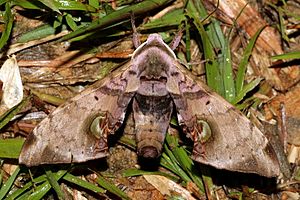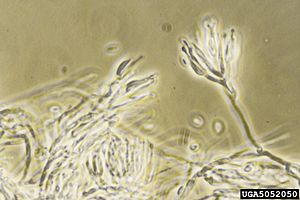List of durian diseases and pests facts for kids
Durians are a popular fruit, but like many plants, they can get sick or be bothered by pests. Most of what we know about these problems comes from studying the Durio zibethinus species, which is the main type of durian grown for sale. However, there are about a dozen other types of edible durians, and these problems can affect them too.
Contents
Animals That Bother Durians
Some animals eat or damage durian fruit and trees. Farmers often try to stop them, sometimes by scaring them away or building fences. While these animals can be a problem for farmers, some of them actually help the durian plant by spreading its seeds!
Big Animals (Vertebrates)
These are animals with backbones that can cause damage:
- Birds: The black hornbill (Anthracoceros malayanus) might eat the fruit.
- Squirrels: Different types of squirrels, like the grey-bellied squirrel (Callosciurus caniceps) and plantain squirrel (Callosciurus notatus), enjoy eating durians.
- Elephants: The Asian elephant (Elephas maximus) can damage trees.
- Bears: Sun bears (Helarctos malayanus) are known to eat durians.
- Monkeys: The crab-eating macaque (Macaca fascicularis) can also be a pest.
- Rats: Different kinds of Rats, like the Malayan field rat (Rattus tiomanicus), can eat the fruit.
- Wild Pigs: Both feral pigs (Sus scrofa domesticus) and wild boars (Sus scrofa) can cause damage.
Small Animals (Invertebrates)
Most of these are insects or other tiny creatures. They can cause different kinds of damage, from eating leaves to boring into the fruit.
Insects and Spiders (Arthropods)
Many insects can harm durian trees and fruit. Here are some common types:
- Leaf Eaters: Many caterpillars and beetles munch on durian leaves. Examples include the leaf roller (Adoxophyes privatana) and the leaf eating beetle (Aprosterna pallida).
- Sap Suckers: These insects, like cotton aphids (Aphis gossypii) and scale insects (Coccoidea), suck the sap from leaves and stems, weakening the tree.
- Borers: Some insects bore into the stem, trunk, or fruit. The durian fruit borer (Conogethes punctiferalis) and durian seed borer (Mudaria luteileprosa) are big problems.
- Mites: Tiny spider-like creatures, such as the oriental red mite (Eutetranychus orientalis), can cause damage to leaves.
- Termites: These insects, like the Indo-Malaysian drywood termite (Cryptotermes cynocephalus), can damage the wood of the tree.
Other Small Pests
- Nematodes: These are tiny, worm-like creatures that live in the soil and can damage the roots of durian trees. Examples include root-knot nematodes (Meloidogyne sp.).
- Snails: The giant African snail (Lissachatina fulica) can also eat parts of the durian plant.
Bacteria That Affect Durians
Bacteria are tiny living things that can cause diseases in plants.
- Stem Canker: Some bacteria, like Enterobacter sp. and Pseudomonas sp., can cause cankers (sores) on the stems of durian trees.
- Fruit Rot: After durians are picked, bacteria like Erwinia sp. can cause the fruit to rot.
Fungi That Affect Durians
Fungi are another common cause of plant diseases. They can affect the tree while it's growing and the fruit after it's harvested.
- Stem and Root Rot: Fungi like Albonectria rigidiuscula and Fusarium solani can cause parts of the tree to rot, including the stems and roots.
- Leaf Spots and Blight: Many fungi cause spots on leaves or make them die back. Examples include Colletotrichum sp. and Phyllosticta durionis.
- Powdery Mildew: This looks like a white, powdery coating on leaves, caused by fungi like Oidium sp.
- Sooty Mold: This is a black, sooty growth on leaves and fruit, often caused by fungi like Capnodium moniliforme. It doesn't directly harm the plant but can block sunlight.
- Fruit Rot: Fungi like Aspergillus niger and Rhizopus stolonifer can cause durian fruit to rot, especially after harvest.
Oomycetes (Water Molds)
Oomycetes are often mistaken for fungi, but they are a different group of organisms. They love wet conditions.
- Root and Fruit Rot: Phytophthora palmivora is a very serious oomycete that causes root rot, bark rot, and fruit rot in durians. It can kill young trees.
- Leaf Blight: Other oomycetes, like Phytophthora nicotianae var. nicotianae, can cause leaves to blight (wither and die).
Plants That Bother Durians
Some plants can grow on durian trees and cause problems.
- Parasitic Plants: Mistletoe (like Elytranthe barnesii) is a plant that grows on durian trees and takes water and nutrients from them, weakening the tree.
Plants That Live on Durians (Usually Harmless)
These plants, called epiphytes, live on durian trees but usually don't harm them. They just use the tree for support.
- Ferns: The oakleaf fern (Drynaria quercifolia) is an example of an epiphyte.
- Algae: Some algae, like Trentepohlia species, can grow on the tree. If they grow too thick, they might block tiny pores on the tree, which could affect flowering.
- Felt Fungus: Septobasidium sp., also known as velvet felt, is a type of fungus that grows on the bark but usually doesn't cause harm.
Parasites of Parasites
Sometimes, a parasite that harms the durian tree can itself be attacked by another parasite! This is called hyperparasitism.
- For example, Gliocladium roseum is a fungus that can act as a parasite on Phytophthora palmivora, which is a major pest of durians. This means one problem helps control another!
Images for kids






